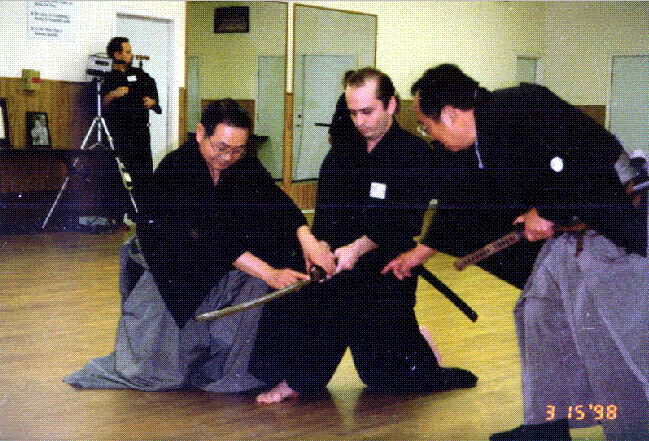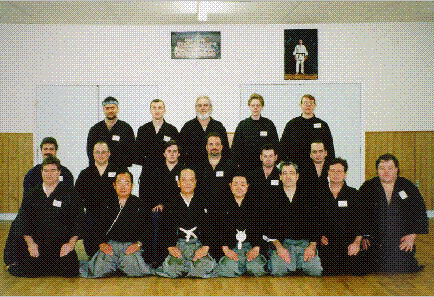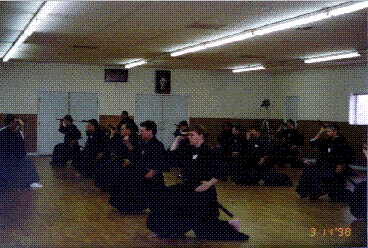

Tomari sensei and
Koshiba sensei from
Chiba in Japan,
instructing a beginner
in Texas.
The Dojo of
Traditional Japanese
Martial Arts in
Denton, Texas was
pleased to host three
friends from the Chiba
dojo of Muso Jikiden
Eishin Ryu (ZNIR).
Kogushi Osamu 8d Jun-Hanshi, Tomari Shohachiro 8d, and Koshiba Kenji 7d presented seminars
on March 14 and 15th, 1998, concluding with embu from each of the visiting sensei. Rank tests
were held on Monday the 16th. These were significant because they included the promotion of our
teacher John Ray to the rank of Renshi.
We got word back from Japan that all the promotions were approved by the Soke. Promotions
were as follows:
John Ray, Rokudan Renshi
Jim Killian, Nidan
Tom Thomas, Nidan
Steve Wagnon, Shodan
Philip Whatley, Shodan
Susan Burke, Shodan
Congratulations to the participants and especially to Ray Sensei on his promotion. Kogushi Sensei was very gracious to have prepared a personal gift for each of the Dan candidates. These were paper fans on which he had inscribed the names of the techniques, Seiza and Battoho no bu for Shodan, and adding Tatehiza no bu for Nidan.
There were actually two simultaneous seminars, one with Kogushi Sensei and the Dan candidates, another with Tomari Sensei and Koshiba Sensei and the newer class. The Dan candidates studied Battoho Kihon and Oku waza, Seiza no bu and Tatehiza. The beginning group studied Seiza no bu, Battoho Kihon and ZNIR Toho.
In addition, private instruction was given on the seven Tachi Uchi no Kurai used in MJER/ZNIR.
In Japan these are usually studied after 6th dan, so I've got plenty of time to worry about it later.
Interestingly enough, there is some jujutsu involved, for example kotegaeshi performed against a
sunegakoi block.
PERSONAL OBSERVATIONS
My foremost impression was of the quality and humanity of these men. There was none of the egotism or callousness so often seen in the martial arts. Kogushi Sensei especially was always relaxed and open, yet dignified and serious in his bearing and waza. I expected the strong iaido and intense training, but I was gratified to see what wonderful gentlemen were produced by years of iaido practice.
All three men had excellent Iaido, but each is distinctly individual. Kogushi Sensei (Ray Sensei tells me) is very much like our teacher Yamashita Sensei of the Chiba dojo, in his techniques and even mannerisms. Kogushi Sensei is laid-back yet serious and his waza are completely relaxed, seemingly casual, yet alert, powerful and exact. Tomari Sensei is small and quick, his movements are sharp and precise. He is also a nice guy, chipper and inquisitive. Koshiba Sensei is short and stocky, his waza are deliberate, smooth, strong and very matter-of-fact.
Kogushi Sensei's embu was particularly inspiring. He presented a number of techniques not often
seen in the U.S. (if ever), including a variety of Kaewaza, several Okuiai and the Bangai no Bu.
These last seemed to me to have a somewhat Chinese flavor to them, and were dramatic to say the
least. Tomari Sensei repeated the demonstration he gave for his 8th dan, and Koshiba Sensei
showed a very fine collection of Seiza and Batto techniques.
TECHNICAL POINTS (Kogushi group)
These notes were compiled by interview with Ray Sensei and Susan Burke. This was her first experience of Tatehiza, but she did survive.
 Gray hakamas on the
front row: left to right:
Koshiba Sensei, Kogushi
Sensei, Tomari Sensei
and Ray Sensei.
Gray hakamas on the
front row: left to right:
Koshiba Sensei, Kogushi
Sensei, Tomari Sensei
and Ray Sensei.
[BATTOHO NO BU]
Kogushi Sensei did Junto So no Ichi/Ni slightly differently, compared to Tanida Sensei (Kyoshi MJER/ZNIR) who visited in February. For example, Kogushi Sensei grasped the saya first before beginning to move, whereas Tanida Sensei grasped it just as he began moving. There were also differences in Shihoto So no Ichi/Ni. On the rearward stab, Kogushi Sensei turned the hip back to ensure the kissaki clears the ribcage, whereas Tanida Sensei used only the saya-biki and shoulder to pull out of the way.
The moral, of course, is to practice techniques as each teacher teaches them. Our final method,
decided in our post-mortem classes after the seminar, was to split the difference, allowing room
for personal expression and dependent on the teacher at the moment.
[SEIZA NO BU]
In noto for Ropponme Ukenagashi, the sword should be angled across the knee, not flat or vertical.
Not too many comments were made on this set. Seiza was blasted through, almost as an
evaluation. Kogushi Sensei must have liked what he saw, and the group moved on.
[TATEHIZA NO BU]
Only two people in this group had experience with Tatehiza. The group was taught to sit properly -- and to endure PAIN! After several minutes, Kogushi Sensei left the group to work out the mechanics on their own. This gave him and Ray Sensei a chance to work on Renshi stuff.
Very small adjustments made it bearable. One trick the students resorted to for hardwood was to take the kneepad and wear it on top of the foot. After a while, everyone settled in to the point where techniques could be practiced.
Kogushi Sensei told the group not to feel bad -- this posture causes intense pain for beginners in Japan too. Kogushi Sensei admitted that he himself had struggled with pain when he started tatehiza. His sympathy and perspective were heartening and helped the group through the growing pains. This reinforced our appreciation of Kogushi Sensei's respect for us as Iaidoka, serious students deserving of candor and encouragement.
The recurring theme of Kogushi Sensei's teaching was "Real Iaido." Real Iaido is when you have
an opponent who can kill you. Everything was presented in terms of the tactics, strategy and
reality of what we are doing. Where is your opponent? What can he do to you? What can you do
to him? These were the constant considerations dealt with for every technique. This was the same
perspective and focus maintained by Tanida Sensei in his visit. If your opponent kills you, you are
not doing Real Iaido.
[RENSHI STUFF]
This included some very advanced points. Without going into too much detail, Ray Sensei told me they worked on the Eishin-ryu method of breathing (kokyu), which imparts tremendous power and fluidity.
Another topic was control of the blinking reflex, when to blink and more importantly when you
cannot blink. This was all in concert with the theme of Real Iaido, subtle but practical issues that
must concern the advanced martial artist.
[GENERAL]
The instruction was almost entirely in Japanese, with only a little English. Our classes are run the same way, so all of us understood. This was the rule even in Tomari Sensei's group, despite Koshiba Sensei's excellent English. This gave the seminar a real feeling of practice in Japan, an experience that most of us have never had.
Just as in our practice, we began reishiki with a standing rei led by the senior student. The sword is held in the left hand with the sageo looped between the first and second fingers and the thumb securing the tsuba, then transferred underhand to the right hand and held at the side at a 45 degree angle. The sempai calls, "Shomen ni Rei," and a deep standing bow is made to shomen. The sword is transferred back to the left hand, and at the leader's gesture, we sit seiza. The sword is pushed forward and transferred to the right hand, then placed alongside the right knee with the sageo looped neatly. Sempai calls, "Sensei ni Rei," and we place left and right hands in a triangle for a seated bow. Then the sword is moved to a horizontal position in front, Sempai calls, "Tou ni taishite Rei," and the seated bow is repeated to the sword.
The training methods are like this. Sensei calls the technique, then demonstrates it, often with particular body language or timing to emphasize key points to be focused on. Then on Sensei's call, the students perform the technique once and then again to the call "Mo Ippon." All of this is done in our school just as it is done in the Chiba dojo, so our guests (and we) felt very much at home.
The student must see the technique, pick up the details he is ready for, and then do his best to perform it. Verbal instruction was given as needed, especially when certain points or new details were being addressed. General corrections were made to the group to avoid embarrassing particular students, but then individual correction was made if it became clear that the intended did not pick up that he/she was the one to whom the correction was directed. Tactical scenarios, of course, were demonstrated physically.
At the close of practice, we performed the same rei in reverse order, with one additional part that
is our custom. Before closing rei, we all line up and perform Ippon Me Mae to shomen. This
emphasizes the role of this technique as the foundation of Eishin Ryu Iaido, and reminds us that our
practice itself is part of rei, the ritual and spirit of Iai.
TECHNICAL POINTS (Tomari/Koshiba group)
In Tomari Sensei's group, we were given thorough individualized training, especially on our mechanics. Often the Sensei would stop the group and go around correcting posture and detail. On the second day, as we went through the forms we each were called to the front to demonstrate techniques for adjustment. This put us on the spot, but also gave us the opportunity for real progress.
 As always my technical notes
represent what I learned at my level
(your mileage may vary). What I did
not note may be as telling as what I
did. Many comments are general,
but are listed in the order they came
up, or the order I remembered them.
If there are no comments, then I was
either already perfect, or perfectly
clueless.
As always my technical notes
represent what I learned at my level
(your mileage may vary). What I did
not note may be as telling as what I
did. Many comments are general,
but are listed in the order they came
up, or the order I remembered them.
If there are no comments, then I was
either already perfect, or perfectly
clueless.
(OPENING)
* Don't bend over, go down to one knee to pick up sword.
* Tachirei hold sword in left, tsuba to mouth level with back of right hand below at bottom third, rotate horizontal, shallow bow.
* When sitting, knuckle of index finger should be on centerline of thigh, relaxed, natural.
[SEIZA NO BU]
(MAE)
* Bring hand straight to tsuka and back to near tsuba before starting push to draw.
* When tip clears, pull saya back and around so koiguchi faces 90 degrees left.
* Good for beginners to stomp on draw, later on good to make no sound.
* Tsuba not higher than shoulder on draw, tip slightly lower.
* Left arm almost straight overhead for furikaburi.
* Advance foot and scoot forward slightly with kirioroshi.
* Don't place forefinger along blade during noto, clasp above the koiguchi.
* Always rise to standing when ochiburi.
* Metsuke 6-9 ft and down when sitting, then on teki, then forward after noto.
(MIGI)
* Turn and draw 45 degrees then cut mae.
(YAEGAKI)
* On two-hand cuts 70% power comes from the left hand, 30% from right.
* Must use wrist snap for one-handed cut (tenouchi not arm).
* Yokochiburi straight out at 45 degrees, parallel to floor.
* Noto draw fast, then slow pushing saya onto sword (KYU-Ha-jo).
* Draw slow, pull saya off fast, cut quick (jo-Ha-KYU).
(UKENAGASHI)
* Draw to left knee in line with thigh.
* Don't advance the left foot, turn and step in place for cut.
* Hold tsukagashira in opening of fist when grasping after noto.
(KAESHAKU)
* Draw 2/3 to right knee then furikaburi.
(TSUKEKOMI)
* Draw 1/3 to right knee then furikaburi.
(NUKIUCHI)
* Keep feet together for powerful triangle when cutting.
* Pull saya off and put strength in little fingers when kissaki pops out.
[BATTOHO NO BU]
(JUNTO)
* Good for beginners to count inside: ichi step, ni grasp tsuka, san draw.
(TSUIGEKITO)
* Cut from shoulder to center of chest on draw (kesagiri).
* Tsugiashi feet always left toe at right heel, never even.
(SHATO)
* Angle of sword almost 45 degrees on 1st kesagiri.
* 2nd kesagiri is through Do, stepping around teki.
(SHIHOTO)
* Pull saya back sharply when thrusting behind, tsuka along forearm, tsuba to nipple.
(ZANTOTSUTO)
* Keep sword angled and push through, cut not tsuke/thrust.
[TOHO]
(EISHINRYU NO MAEGIRI)
* Don't advance with oroshi in Toho.
* Kiai always "EI!" (not HEY or YA or HO or weird gutturals)
(MUGAIRYU NO ZENGOGIRI)
* Draw upwards then cut men 45 degrees with stomping action.
(SHINDOMUNENRYU NO KIRIAGE)
* Cut to groin, not knee on kesagiri.
(SUIORYU NO SHIHOGIRI)
* Don't withdraw foot, bring tsuba to mouth, then lower sword to waki and cut 45 degrees past
(3rd cut).
(HOKIRYU NO KISSAKEGAESHI)
* Thrust almost straight, clasp blade between thumb and forefinger and push.
CONCLUSION
We trained hard for two days, had a wonderful party at John Ray's house, treated our guests to some great Texas barbecue, and showed them some of the sights of the great Dallas / Fort Worth / Denton metroplex. We only got a little sightseeing done, due to the weather and the fact that the sensei were single-minded in dumping as much information as possible on us. We all left the weekend a little bit shell-shocked, trying to absorb everything at once.
Our sensei left us dazed but wanting more. I look forward to their return next year.